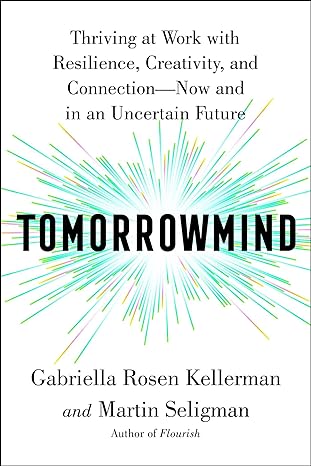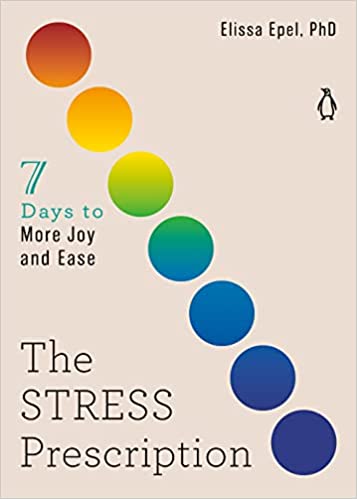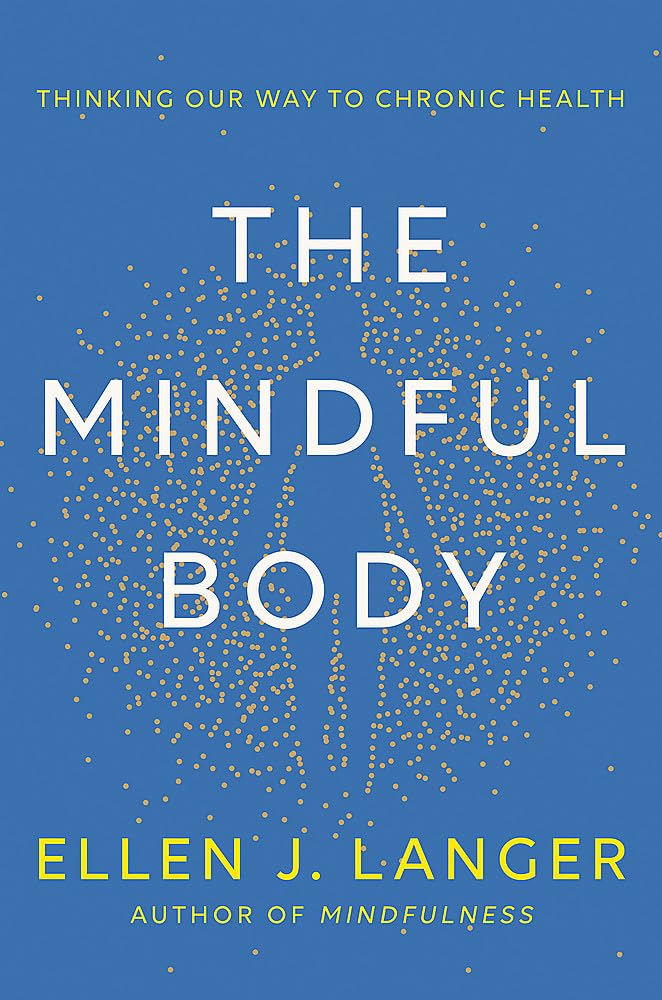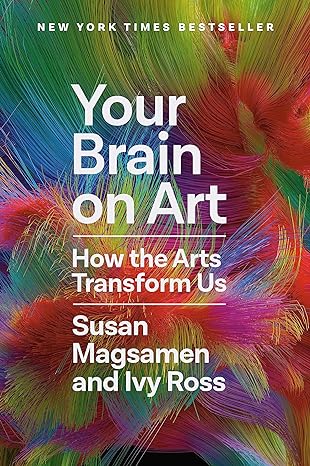Six favorite books of 2023 to help harness the stress response and boost curiosity, wonder, and brain health at work,
It’s hard to address important issues in our lives or in society if we are stressed, depleted, and isolated. Perhaps that’s why many of 2023’s favorite books offer approaches for real self-care. They focus on how to manage stress, find more happiness in life, seek wonder and inspiration, appreciate art, understand our personal strengths, or change our mindset in healthy ways.
In each of these books, the authors aspire to help us find greater health and happiness as we cope with life in the present, while working toward a healthier, more compassionate world for all.
 Tomorrowmind: Thriving at Work—Now and in an Uncertain Future, by Gabriella Rosen Kellerman and Martin Seligman
Tomorrowmind: Thriving at Work—Now and in an Uncertain Future, by Gabriella Rosen Kellerman and Martin Seligman
Now that workplaces are emerging from the intense demands of the pandemic, they are in an unprecedented position to reflect and try to transcend outdated approaches to organizational structure, policy, and culture. In Tomorrowmind, coauthors Gabriella Rosen Kellerman and Martin Seligman offer an abridged history of organizational thinking and design, then draw from scientific research, case studies, and in-depth interviews to share key insights and actionable strategies for real and impactful organizational transformation.
Part of what Tomorrowmind covers is the topic of thriving at work, the science behind it, and why it’s important. To promote thriving at work, the authors recommend several strategies to help organizations enhance resilience, strengthen connection, make sure people know they’re valued, and provide a courageous, aspirational shared vision.
To increase workplace resilience, for example, Tomorrowmind recommends slowing down and reinterpreting difficult experiences, doing the “Best Possible Self” practice to increase optimism, learning to put setbacks and failures into perspective, and acting with more self-compassion.
With an eye toward future challenges—like AI and climate change—Tomorrowmind also offers clear strategic guidance to help organizations nurture a culture of thriving and recast traditional structures and policies to maximize creativity, minimize wasted effort and time, and “future-proof” themselves against possible catastrophe in a volatile, uncertain, complex, and ambiguous landscape.
 The Stress Prescription: Seven Days to More Joy and Ease, by Elissa Epel
The Stress Prescription: Seven Days to More Joy and Ease, by Elissa Epel
Though this book came out late in 2022, it was too important not to mention. Elissa Epel, a premier stress researcher, has put together a short primer on how to life a happier, healthier life through effective stress management.
As Epel writes, not all stress is inherently bad; so, we shouldn’t aim for a stress-free life. We need our physiological stress response to survive and to respond to challenging situations. But if we are constantly vigilant—which many of us are these days—it ages us unnecessarily.
How can we use stress to our advantage and soothe it when it’s overwhelming? Epel has several evidence-based tips, including learning how to embrace uncertainty, let go of uncontrollable outcomes, and recognize our stress response’s utility. We can also deliberately seek more joy, time in nature, small stressors (to build resilience), and occasional deep rest (where we are free from responsibility or our ubiquitous cell phones).
As Epel writes, “Anything worth doing will have aspects of stress woven through: challenge, discomfort, risk. We can’t change that. But what we can change is our response.” Changing your relationship to stress by taming it is key.
 The Mindful Body: Thinking Our Way to Chronic Health, by Ellen J. Langer
The Mindful Body: Thinking Our Way to Chronic Health, by Ellen J. Langer
We’ve all heard about “mind/body connection.” But do we fully understand its implications for our health and well-being?
Not according to Ellen Langer’s book, The Mindful Body. Langer reveals a whole world of fascinating research looking at how our beliefs about aging, risk for contracting disease, and the effectiveness of potential treatments affect health, and how changing our mindset can lead to surprisingly better results.
For example, one study found that giving people information about their (fictitious) level of risk for obesity changed their metabolism and how they felt about exercise and hunger (regardless of their actual level of risk). Another found that messing with people’s perception of time affected how much energy they expended doing a task.
In other words, expectations matter; so, we must be careful what we put in our minds lest it become a self-fulfilling prophecy. “Diagnoses, while useful, direct attention to only a fraction of lived experience; context influences our physical responses,” writes Langer.
To that end, she suggests we become more mindful about our inner experience and outer circumstances—and more skeptical of dire predictions. By paying attention to our ever-changing experience, she argues, we might all change the trajectory of our health—and enjoy happier lives.
 Your Brain on Art: How Art Transforms Us, by Susan Magsamen and Ivy Ross
Your Brain on Art: How Art Transforms Us, by Susan Magsamen and Ivy Ross
Even during our earliest history, humans made art. This suggests an evolutionary purpose—that engaging with art somehow helps us survive.
Susan Magsamen and Ivy Ross’s book, Your Brain on Art, shows us why that might be the case. Appreciating or making art—in all its forms, whether viewed in a museum or crafted yourself—involves using many parts of your brain, including those that process our senses and are involved in emotion, memory, and cognition. It also brings us pleasure and insight.
“There is a neurochemical exchange that can lead to what Aristotle called catharsis, or a release of emotion that leaves you feeling more connected to yourself and others,” write the authors.
Studies show that engaging in art can do much for our brains and bodies. It improves our heart health and cognitive fitness, and helps us heal from illness and trauma. Art also nurtures curiosity and emotional intelligence, while making us think differently about life, embrace ambiguity, and feel awe.
This means we should all incorporate art into our daily lives for more well-being, argue the authors.
“The arts can transform you like nothing else. They can help move you from sickness to health, stress to calm, or sadness to joy, and they enable you to flourish and thrive.”
Finally, though we don’t want to blow our own horn, we would be remiss if we didn’t mention two books that came out this year written by Greater Good staff:
Awe: The New Science of Everyday Wonder and How It Can Transform Your Life, by Dacher Keltner, where Keltner reveals the science of awe and how it can make us happier and more connected to something greater than ourselves (Penguin Press, 2023, 335 pages).
Seek: How Curiosity Can Transform Your Life and Change the World, by Scott Shigeoka, where Shigeoka shows us the importance of being curious for bridging differences and transforming our world (Balance, 2023, 256 pages).
 — Adapted from article by Jill Suttie, Psy.D., Jeremy Adam Smith Emiliana R. Simon-Thomas, Ph.D., Maryam Abdullah,Ph.D., at Greater Good. Based at UC-Berkeley, Greater Good highlights ground breaking scientific research into the roots of compassion and altruism. Copyright Greater Good.
— Adapted from article by Jill Suttie, Psy.D., Jeremy Adam Smith Emiliana R. Simon-Thomas, Ph.D., Maryam Abdullah,Ph.D., at Greater Good. Based at UC-Berkeley, Greater Good highlights ground breaking scientific research into the roots of compassion and altruism. Copyright Greater Good.


